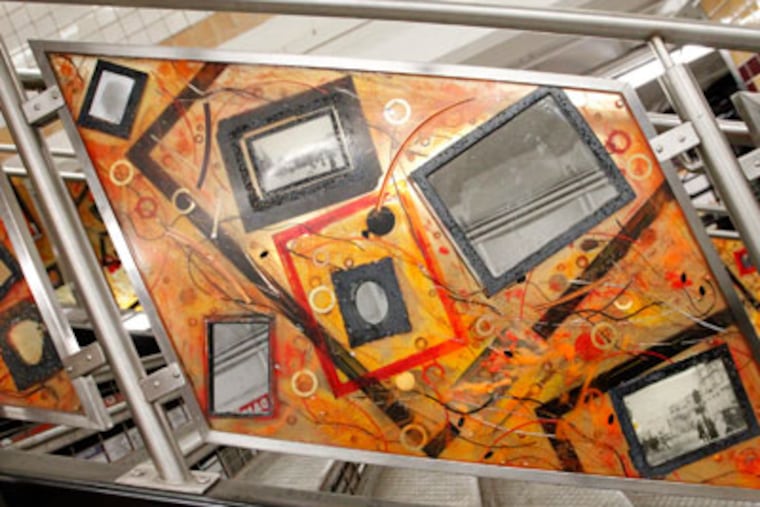SEPTA's Art in Transit enlivens Philadelphia commute
“WALKING ON Sunshine,” the newest SEPTA Art in Transit piece on the platforms of the rehabbed Spring Garden station, is unexpectedly cheery and colorful. With its snappy, patent-leather shine, it gives the underground station “soul,” as one appreciative rider put it. This creation of Philadelphia artist Margery Amdur is one of 21 art projects SEPTA has created systemwide since 1998, when Art in Transit began at the behest of then-new SEPTA general director Jack Leary. Leary came from Boston, which had an art program in its MTA; he wanted art for Philadelphia, too. Everybody up and down the SEPTA line embraced the idea, according to Elizabeth Mintz, who came on board at the same time as Leary and is the authority’s director of communications and manager of the Art in Transit program.

"WALKING ON Sunshine," the newest SEPTA Art in Transit piece on the platforms of the rehabbed Spring Garden station, is unexpectedly cheery and colorful. With its snappy, patent-leather shine, it gives the underground station "soul," as one appreciative rider put it.
This creation of Philadelphia artist Margery Amdur is one of 21 art projects SEPTA has created systemwide since 1998, when Art in Transit began at the behest of then-new SEPTA general director Jack Leary. Leary came from Boston, which had an art program in its MTA; he wanted art for Philadelphia, too. Everybody up and down the SEPTA line embraced the idea, according to Elizabeth Mintz, who came on board at the same time as Leary and is the authority's director of communications and manager of the Art in Transit program.
An art program in a transit system may seem superfluous, or even questionable when times are tough financially for mass-transit systems. But funding for Art in Transit comes from the Federal Transit Administration; no city or state money is used. When the Spring Garden station (and the nearby Girard station) renovations qualified as shovel-ready projects for 2010 federal stimulus funds, Art in Transit received FTA funds for both stations. Amdur's "Walking on Sunshine," selected from an open call for artists, had a budget of $150,000.
The FTA considers art and design programs one of its important initiatives, right up there with planning and safety. The goal is to build ridership by making stations, bus shelters and other infrastructure attractive to riders. "Good design and art … give vibrancy to a community's public spaces, and make the public feel welcome," the agency says on its website. FTA-supported art-in-transit programs exist in 17 other states.
"It's not just about fine art; it's a way to develop a conversation with the communities we serve," Mintz agreed. "Art is a way to build a relationship with the community. When we reconstruct a station, shiny stainless steel and brick goes only so far. We want to get the personality of the community in there. And the art brings in the community."
Artists must explore the neighborhood around a transit station to discover landmark moments in the community. There are community meetings where input from artists and the public is welcome. "The object is to encourage community ownership," said Marsha Moss, an independent public art curator and consultant who administers the Art in Transit program with SEPTA.
"Public art is two words," she said. "If it's not meaningful to the public, it's not successful as public art."
SEPTA's art projects vary widely from station to station. From mosaics and murals to Amdur's floor piece, the artists' individual voices come through loud and clear. "We try very hard not to do the same project over and over," said Mintz. "We have a list of what we'd like to see — and not just murals and benches."
Flower power
As an installation artist, Amdur was comfortable working with floors for her project. "In most of my installations, the floor acted as an additional picture plane to work on," she said. A floor piece conveys a journey. "I want people to get the sense of journey, metaphorically and literally."
In her studio, Amdur made drawings that were a mélange of flowerlike shapes in various colors and a variety of more hard-edged shapes that overlap and create a sense of space. The piece takes inspiration from Vincent Van Gogh's sunflower paintings and Andy Warhol's pop-art sensibility — an improbable combination, but one that works.
Scaled up 400 percent, printed on special fabric and embedded under layers of shiny resin that was poured on-site, the drawings still have a handmade feel. Along the dreamy, 4,000-square-foot walkway, tropical colors and organic shapes seem to float in layers beneath the glassy surface underfoot.
The floor has a 35-year warranty; a new coat of resin will be applied every five years. Although it looks slick, it isn't. (The surface meets engineering specs for a public walkway.)
Amdur got lots of "wows" the first day as people thought they were walking on glass. And although many young commuters seemed to be concentrating on their cellphones, Amdur saw their eyes glancing down while they talked. "If I can get eyes roaming the floor before they get on a train, that's great," she said. n
Art Attack is a partnership with Drexel University and is supported by a grant from the Knight/NEA Community Arts Journalism Challenge, administered by the Greater Philadelphia Cultural Alliance.